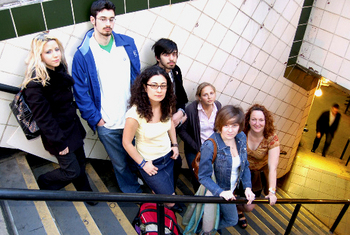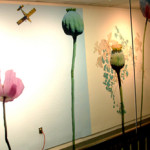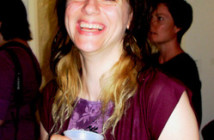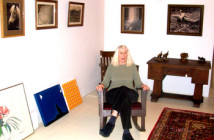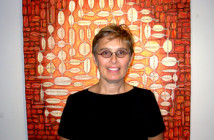In the late 60s and 70s, the dark ages for the arts in Boston, when the Institute of Contemporary Art was the only, struggling, act in town, Stephen D. and Susan Paine, were conspicuous for their enthusiasm and support of contemporary art. With passion and insight he acquired work for the corporate collection of Wellington Management, of which, he was a founding partner, as well as for their private collection.
The Paines clearly loved living with art and enjoyed being in the mix of cutting edge artist events. He was confined to a wheel chair but that never prevented him for being carried up stairs, if necessary, to visit studios or attend openings of the avant-garde, loft based, Atlantic Gallery, operated by the artists/ musicians, Jeff and Jane Hudson. They also bought works from their shows that helped to sustain the space during a time when there were little of no venues for the abundance of work that was being created by a new and energized generation of artists. It was the era of Mayor Kevin White, and his assistant, later Congressman, Barney Frank. Drew Hyde was pulling the ICA back from the brink of extinction. There was much talk of the “New Boston” represented by the New City Hall and the nearby revitalization of Quincy Market. In the arts, the Paines were in the thick of it. In this regard, Stephen was continuing a tradition of his Boston Brahmin family and their historic association with the Museum of Fine Arts.
In 1997, Stephen passed away at the age of 65. A scholarship fund in his name was established. It is administered by the Boston Foundation, the Artists Foundation and the Boston Art Dealers Association (BADA).
Arthur Dion, the president of BADA and director of Gallery NAGA, discussed the background of the program. “The Boston Art Dealers Association, which was formed in 1989, decided in 1997, to establish a program of benefit to the broader visual arts community and settled upon the idea of a scholarship program that would award, on a competitive basis, no-strings grants to students entering their fourth and final year of training in any Boston undergraduate studio degree program.
“Having conceived the project, we thought to bring the project to Stephen D. Paine, who, with his wife Susan, was assembling one of the outstanding collections of contemporary art in the area, both privately in their home and also at his firm, Wellington Management. Both also demonstrated a particular affinity for young artists and the schools at which they train. Before our appointment, Steve Paine died, and we named the scholarship after him.”
Now in its fifth year, the jurors have included: Joe Thompson, director of Mass MoCA, Linda Shearer, formerly director of theWilliams College Museum of Art, Joe Ketner, the former director of the Rose Art Museum, Jill Medvedow, director of the ICA, and this year, William Stover of the Museum of Fine Arts.
Several months ago, Dion called to say “I am making you an offer you cannot refuse.” The opportunity to host the annual exhibition for the Paine Scholarships. It was enticing but also daunting. Generally it takes up to two years to develop the gallery program and this was very short notice. So, how to patch it in at the last moment? Also how to pay for it out of your limited funding? When I discussed this possibility with my gallery associate, James Manning, he jumped at the opportunity. It represented a significant homecoming as Manning, the former director of Gallery FX, which was devoted to showing student work, installed the first Paine show. Gallery FX was located on the ground floor of the former Paine Furniture Company which also houses NESAD at SU. After some negotiation with Dion we agreed to take on the project with the understanding that Manning would be entirely responsible for working with the nine artists and designing the installation of work that ranged from painting, drawing and photography to video and installations.
After some internal discussion we decided to schedule the show for immediately after the school semester. This provided the opportunity to expand the exhibition beyond the main gallery. Audrey Goldstein, the chair of the fine arts program, offered use of the large studio space that is next to the gallery. Also, next to the gallery, we were given access to hall space that is used by the fine arts program. Accordingly, we were able to triple the space normally devoted to our exhibitions. Manning’s plan was to derive a design that would include the two winners, Mark Chariker, and Tricia O’Neill, both of the School of the Museum of Fine Arts, as well as the finalists: Lily Brooks, of the Massachusetts College of Art, Sean Carroll, Mass Art, Lina Maria Giraldo, Mass Art, Melissa McGorty, Mass Art, Sandra Powers, Mass Art, Alex Ward, Mass Art, and Heather Lee Wilson, of the Art Institute of Boston.
One of the problems for Manning was how to properly upgrade the fine arts studio into a suitable gallery. The solution was to build walls to partition the space and use this to install two video projections by Sean Carroll, collages taken from daily life, and Sandra Power’s “Little Mary” as well as a series of family portrait photographs by Lily Brooks. The video by Powers is particularly arresting as she worked with 16 mm film which she painted on directly, scratched and distressed, before its transfer to video. It has a spooky feeling evoking Friedrich William Murnau’s “Nosferatu” but with a score by Phillip Glass and the Kronos Quartet.
The main gallery includes the “winners” the auto body shop photographs by Tricia O’Neill, and “exploding landscapes” by Mark Chariker. His landscapes have sparked interest from several local art dealers trolling the show for potential new talent. This is surely a hot show for savvy dealers and collectors. Also in the gallery is a wall of narrow, vertical, color photographs, by Heather Lee Wilson, of ghostly women in wedding dresses in groupings with space in between. The piece “The Closest I’ve Been” relates to her childhood dream of a Guardian Angel. A video monitor displays an animation “Sarariman” by Alex Ward that tells the story of a trip to Japan. It involves a man who lives and dies for his company. He finds a flower and chases it through a cyber-punk space where he watches it morph into a forest.
In the corridor space we encounter the cutout dolls, including a life size girl in her underwear. The works by Melissa McGory involve collages of her prints and evoke the use of pictorial narrative in fashion.
I happened to be in the office on the day that the Colombian born artist, Lina Maria Giraldo, came by to discuss her work with Manning. She related that while the Colombian trade in cocaine is widely know there is little attention paid to the fact that the Cartel has been cultivating poppies to make the opium that is transformed into cheap and highly profitable heroin. The irony is that this new drug industry was an opportunistic response to the clampdown on heroin production in Afghanistan by the former Taliban. Here her work brilliantly calls attention to the issue by a clever use of applying long, graceful, decals of single strands of poppies and small planes, used to transport drugs out of the jungle, directly to the glass wall that surrounds the staircase leading into the gallery. Next to this display is a video monitor with a pulsating, detailed view of a poppy field. There is a concealed camera that picks up images of passersby that are then embedded live into the video stream. It is her way of pulling us in and making us involved in the tragedy of the international drug trade which is destroying her nation and infesting ours. This is smart, compelling, tough, righteous work.
Everyone involved is to be thanked and congratulated for allowing this opportunity to recognize and reward the best and brightest art students in Boston’s class of 2006. In loving memory of Stephen D. Paine.
"The 2006 Stephen D. Paine Scholarship Exhibition" was on view May 18 through June 2 at The New England School of Art & Design at Suffolk University.
The Artists included were: Lily Brooks, Sean Carroll, Mark Chariker, Lina Maria Giraldo, Melissa McCorty, Tricia O’Neill, Sandra Powers, Alex Ward and Heather Lee Wilson.
Group image by James Manning.
Artwork images by Charles Giuliano, courtesy of the artists.

